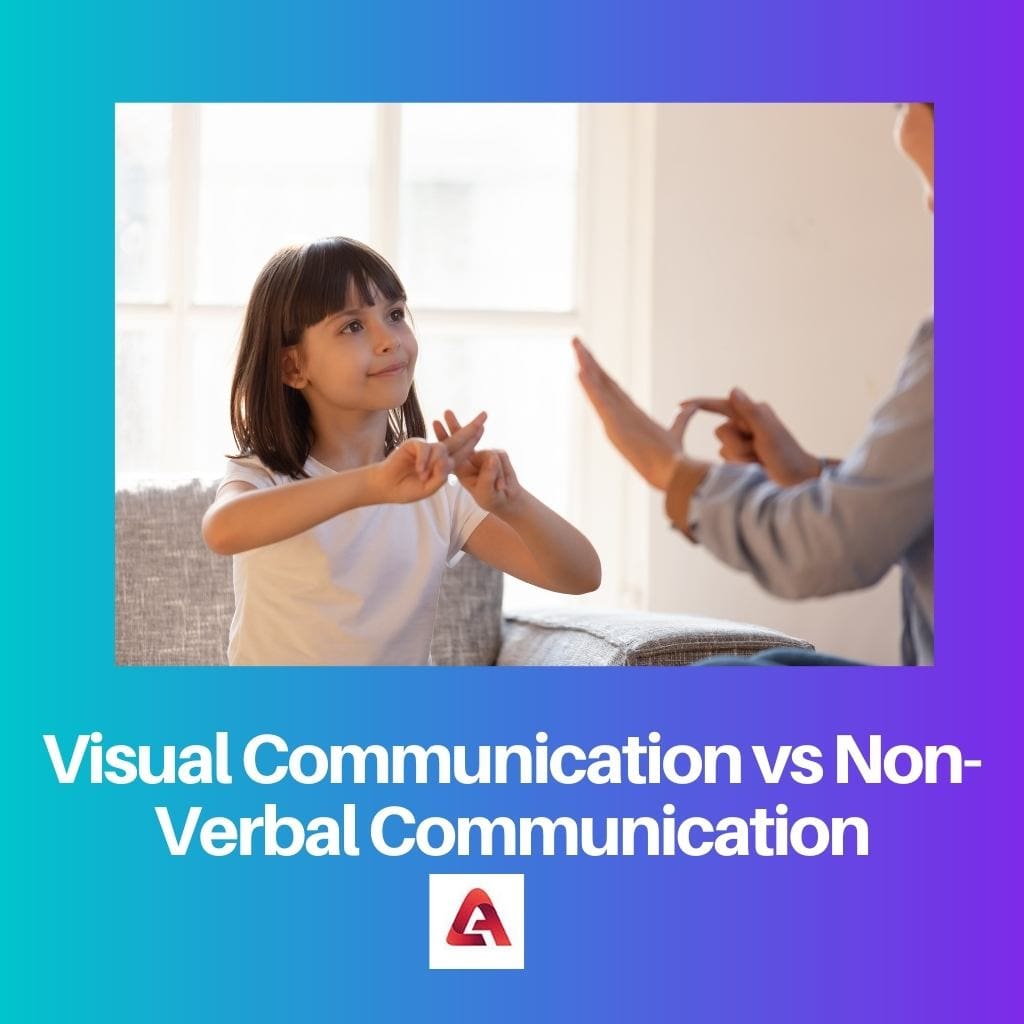Communication is sharing and transferring information to an individual or a group.
The process involves three components: The sender, the receiver, and the information to be communicated.
It is inevitable for a person to communicate effectively to ensure that there is no ambiguity for the receiver in understanding and receiving the information.
Key Takeaways
- Visual communication transmits information through visual aids such as pictures, graphs, and videos. In contrast, non-verbal communication uses body language, facial expressions, and gestures to convey meaning.
- Visual communication is more objective, while non-verbal communication is more subjective and open to interpretation.
- Both forms of communication are essential in interpersonal interactions and can significantly impact how messages are perceived and understood.
Visual Communication vs Non-Verbal Communication
In visual communication, visuals convey messages through pictures, graphs, etc. To define a difficult topic visual communication is taken into consideration. In verbal Communication different means like body language, gestures, etc are used to convey messages. It is talking without the use of words.

Visual communication is vital in retaining enthusiasm and keeping the receivers interested during communication. It is the most ancient mode of communication. Visual communication enhances and aids in better reception of information among the receivers. This is perfectly suitable while communicating with a larger audience. Visual communication techniques should be adopted while communicating complex and complicated information.
Non-verbal communication is the act of sharing information without the use of words. It uses nonverbal expressions like facial expressions, eye contact, body language, proximity, time, and posture. This type of communication came into existence with the study of communication between animals conducted by Charles Darwin. Non-verbal communication is believed to unveil more information and details than verbal communication would do.
Comparison Table
| Parameters of Comparison | Visual Communication | Non-verbal communication |
|---|---|---|
| Definition | Visual communication is the type of communication in which visuals communicate or transfer information. | Non-verbal communication is defined as sharing information and ideas without using words. |
| Usage | Visual communication can be the best choice to communicate with a larger and more versatile group who speak different languages. | Non-verbal communication is mostly suited for one-to-one communication. |
| Involvement of sight | All types of visual communication can also be called non-verbal communication. | All non-verbal communication. |
| Example | PowerPoint presentation, flowcharts, graphical representations, and also videos and images. | Handshake, shrugging, nodding the tone and pitch of one’s voice. |
| Level of difficulty | It is easier to understand any group of audience. Hence it can be widely used irrespective of the concepts. | It is not straightforward and requires more attention and knowledge to perceive. |
What is Visual Communication?
The visual elements possess five characteristics: objects, models, maps, graphs, and photographs. In addition to characteristics, it also has seven components.
Colour, tones, texture, shape, balance, figure, and hierarchy. This communication mode is best suited in educational fields to understand concepts, politics, and social media and is widely used in science, technology, and research.
When the receiver perceives the information the sender communicates through my eyes, it is called visual communication. It is communicated with the help of charts, graphical diagrams, and graphics.
Some examples are infographics, illustrations, and visually interactive content. Animation and data visualisation are well-known and efficient visual communication methods.
The thought, ideas, and information can be wholly understood and perceived unambiguously using three visual elements.
From the wide variety of options available in visual communication, it is inevitable not to go overboard but select the essential elements to communicate unambiguously.
It is all about choosing the correct components based on your necessities.
It is also necessary as it is the factor that plays a significant role in drawing the attention and luring your recipients, retaining their curiosity and interest with them.

What is Non-Verbal Communication?
Non-verbal communication is communicating with voice, sight, body language, tone, and proximity, excluding words’ involvement.
At places where you are judged for your communication skills, they notice your non-verbal communication as much as they see your verbal communication.
One has to concentrate and learn to enhance non-verbal communication to ensure one creates good impressions in others’ minds.
The reason why non-verbal communication is paid more attention to is that it conveys both international and non-intentional behaviour of an individual, which is why interviewers and recruiters notice and use this to pick out suitable candidates for their organization.
Even in business communications and partnerships, this can significantly bring you many opportunities and take them away if you aren’t conscious enough.
Though people can seem to hide or not express exactly how they feel, though they would not tell you the truth, whereas the gesture, expression, and non-verbal factors will, however, reveal the truth, the tone of a person’s voice also conveys more emotion and truth than their words.
For example, the speaker will be interested when you smile and nod attentively. When you give curt replies or shrug, the speaker will lose enthusiasm. This is how non-verbal communication is perceived.

Main Differences Between Visual Communication and Non-Verbal Communication
- Visual communication is the usage of eyesight for the recipient of the information to understand it. Non-verbal communication is communicating, sharing, or transferring information without using words.
- Visual communication will bridge the gap brought by language differences and break down all the language barriers. Non-verbal communication might not suit a larger group of recipients. It may need a different understanding level to receive the information, which is different for everyone. This can be used for a similar group of people, though.
- Visual communication is a derived version of non-verbal communication that only utilizes the sense of sight. Non-verbal communication also includes the involvement of sight and many more.
- Visual communication is easy to understand. It doesn’t require many skills or knowledge, making it possible to be used by almost anyone for communication. It also makes the recipients retain the information received for a longer time. Non-verbal communication requires greater understanding, including encoding and decoding, each done by the sender and receiver.
- Visual communication involves flow charts, diagrams, graphs, mindmaps, and graphics. Non-verbal communication includes facial expressions, body language, and proximities.






